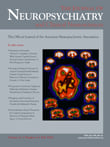Delirious Mania Associated With Bipolar Disease in a Brazilian Patient: Response to ECT and Olanzapine
To the Editor: The subtype of catatonia designated as delirious mania is characterized by excessive motor activity, combined with factors such as: unsystematic speech, disorientation, confusion, and psychosis, with acute onset of symptoms. Delirious mania is associated with bipolar disorder, and its symptoms encompass mania and acute mental confusion, when additional tests do not indicate other diseases. It was initially described by Calmeil 1 in 1832, but a subsequent case series published by Luther Bell 2 in 1849 described 40 patients with the condition among 1,700 admissions to McLean Hospital. Three-quarters of these patients died. Many authors have suggested that 15%–20% of all patients with acute mania show signs of delirium, contrary to the notion that it is not as common. 3 Patients with this syndrome experience significant morbidity 4 and a high rate of mortality without treatment.
There is no clear consensus on what clinical characteristics are associated with delirious mania or what treatments are effective. Recognition of this syndrome is further complicated by the fact that many cases in delirious psychiatric patients are precipitated by medical or neurological conditions or use of psychoactive substances. 5
Case Report
We report the case of a 42-year-old man diagnosed with bipolar disorder, initiated when he was 27 years old, who experienced irregular treatment due to living in a rural area. There was 1 year without treatment. He came to the emergency hospital with acute onset (7 days) of severe symptoms such as irritable mood, reduced need for sleep, pressured speech, racing thoughts, distractibility, fluctuating levels of consciousness, disorientation, disorganized behavior, extreme psychomotor agitation, pressured speech, hypersexuality, visual hallucinations, stereotypy, echolalia, echopraxia, tachycardia, rapid heart rate, and grandiosity.
We started treatment with lorazepam, up to 10 mg, without improvement. Lithium carbonate, 900 mg per day, also failed to cause improvement. After haloperidol, 10 mg/day, and thioridazine, 600 mg/day, the symptoms worsened, and he became more hostile and angry and experienced increased psychomotor activity, resulting in more weight loss and delirium. His laboratory studies, including CBC, CPK, serology for syphilis and AIDS, thyroid function tests, and renal functions, were within normal limits. A brain CT revealed no pathological findings.
After 20 days without improvement, we indicated ECT. After the third session, he was better, chatting adequately and sleeping from 6 to 7 hours per night. However, there were technical problems and the ECT was suspended. After 2 weeks, he began to gradually worsen. We started a treatment of olanzapine, up to 30 mg/day. After 2 months, the patient showed marked clinical improvement in his symptoms of catatonia and delirious mania. The response to ECT was much faster. He was maintained on olanzapine, 15 mg/day, and was referred to the outpatient clinic for psychiatric follow-up.
Discussion
An antipsychotic, even atypical, should be used with great caution in catatonia because it can cause neuroleptic malignant syndrome or even aggravate the catatonia, especially the malignant catatonia. However, Nicolato et al. 6 have reported a response to olanzapine for catatonia associated with bipolar disorder.
1. Calmeil LF: Dictionnaire de Medicine: Our Repertoire General des Sciences Medicales Considerees Sous le Rapport Theorique et Pratique, 2nd ed. Bechet, Paris, 1832Google Scholar
2. Bell L: On a form of disease resembling some advanced stage of mania and fever. Am J Insanity 1849; 6:97–127Google Scholar
3. Fink M: Delirious mania. Bipolar Dis 1999; 1:54–60Google Scholar
4. Friedman RS, Mufson MJ, Eisenberg TD, et al: Medical and psychiatrically ill: the challenge of delirious mania. Harv Rev Psychiatry 2003; 11:91–98Google Scholar
5. Karmacharya R, England ML, Ongür D: Delirious mania: clinical features and treatment response. J Affect Disord 2008; 109:312–316Google Scholar
6. Nicolato R, Romano-Silva MA, Correa H, et al: Stuporous catatonia in an elderly bipolar patient: response to olanzapine. Aust N Z J Psychiatry 2006; 40:498Google Scholar



